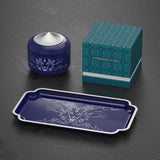Vietnam as a nation has come very far, but not without its fair share of turmoils and troubles. In many ways, it's like its national flower, the lotus, remarkable for growing out of the mud but emerging in beauty.
A tumultuous past
Visit Ho Chi Minh City, Vietnam's financial centre, and you'll be greeted with roads jam-packed with motorcycles, alongside streets of people selling everything from food to jewellery. Wandering through the restaurants, jazz bars, and luxury boutiques that have started to spring up across the city, one might be tempted to forget that not too long ago, this was a city ravaged by the Vietnam War. In fact, even before that, for much of its history, Vietnam has found itself in a painful struggle against other nations for its independence.

Every year, more than a million people come to Vietnam to see the Imperial City in Huế¹, one of the country's famed UNESCO world heritage sites, and many of them will tell you how 'Chinese' it looks – which is not surprising. The Chinese influence on Vietnam is far and wide-spread because in 111 BC, Vietnam was invaded by the Chinese Empire and then subjected to Chinese rule for more than a thousand years. A successful revolt in 938 AD ended the Chinese rule in Vietnam but its influence continued long after.

The Chinese were not the only ones with their eyes set on Vietnam. If you've ever eaten 'Banh Mi', you'll realise that it's basically a Vietnamese version of the French baguette, because in the mid-19th century, Vietnam once again found itself in the hands of another aggressor. This time, it was colonised by the French, becoming part of French Indochina.
But one of the darkest chapters of Vietnamese history would come later in the 1950s in the bitter 20-year conflict we now refer to as the 'Vietnam War'. The war killed millions of Vietnamese and left generations suffering from the effects of chemical warfare. However, against all odds, the Vietnamese forces prevailed, establishing the Socialist Republic of Vietnam.
The Present
Today, less than 50 years on, Vietnam has transformed itself from one of the poorest countries in the world to one of South East Asia's fastest-growing economies. People are optimistic about their future and the country recently even held the second Trump-Kim summit. Vietnam's story resembles the lotus, with its roots planted in the muddy river bed but despite the murky environment, rises to the surface of the water, emerging with a beautiful bloom in the sunlight.

In 2011, a poll conducted across several Vietnamese cities cemented the lotus' status as the country's national flower and a symbol of the noble character and spirit of the Vietnamese people. Its traces can be seen everywhere, from the logo of Vietnam's national carrier, Vietnam Airlines, to the design of the Bitexco Financial Tower in Ho Chi Minh City, once Vietnam's tallest building. And, a new cultural centre in the shape of the lotus is currently being planned for Hanoi.
The journey is still not over for Vietnam. There is much to contend with and the country’s success will in no small part depend on how the communist country continues to grapple with capitalism and the free market. But, just as the lotus emerges from the depths into the light, one can certainly be hopeful for the future of this magnificent country.
Inspired by the Lotus? So are we. Our Lotus Silk Bangle collections celebrate the delicate beauty of this remarkable flower.

Lotus Collection
Footnotes:
¹Construction for the Imperial City in Hue began in 1804, centuries after Vietnam gained independence from the Chinese empire and is one of many examples of the continued Chinese influence in Vietnam.
Cover image:
The Ceramic Mosaic Mural in Hanoi. (Image credit: diggers2004 / Wikimedia Commons)
Footnotes:
¹Construction for the Imperial City in Hue began in 1804, centuries after Vietnam gained independence from the Chinese empire and is one of many examples of the continued Chinese influence in Vietnam.
Cover image:
The Ceramic Mosaic Mural in Hanoi. (Image credit: diggers2004 / Wikimedia Commons)


















































